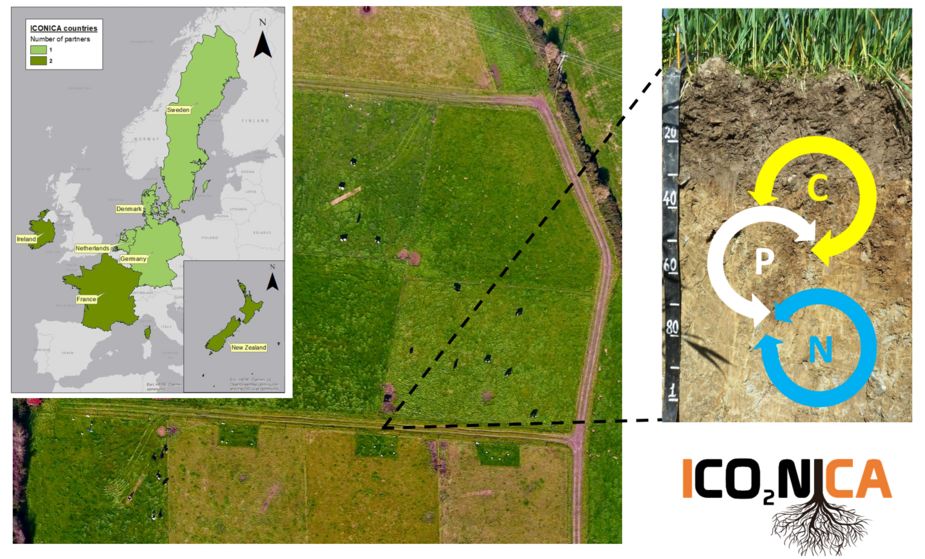ICONICA
| Start: | 01 April 2022 (External Call project) |
| Duration: | 36 |
| Aim: | Impact of long-term phosphorus additions on Carbon sequestration and Nitrogen Cycling in Agricultural soils |
| Contact: | Coordinator Dr Giulia Bondi, Teagasc Environment, Soils and Land-Use Department Johnstown Castle Research Centre, Wexford, Ireland. |
| Project Webpage | ICONICA - Teagasc | Agriculture and Food Development Authority - Visit this project site for latest updates |

Project Background/Context. The EU Green Deal through the Farm to Fork and Biodiversity 2030 strategies aims to make Europe a climate-neutral continent by 2050 while ensuring food security. Achieving this objective will require the adoption of sustainable agricultural soil management practices. Management of agro-ecosystems to enhance both soil and subsoil organic carbon storage is a strategy for mitigating climate change by helping to stabilise emissions. However, long-term soil organic carbon (SOC) storage is dependent on many factors, especially the interactions with other nutrients. Soil phosphorus (P) is a key nutrient for crop growth and P limitation can reduce plant and soil microbial biomass affecting SOC sequestration and reduce nitrous oxide (N2O) emissions from nitrogen fertiliser application.
Knowledge gap. Across the world P fertilisation recommendations have been optimised for achieving agronomic targets such as maximising crop yield. The need for a soil specific understanding of the effects and fate of added P fertilisers to agricultural soils is critical for developing sustainable P fertilisation advice that considers both agronomic and environmental outcomes.
Overarching Aim. ICONICA aims to identify optimal P fertilisation to underpin sustainable production, enhance nutrient efficiency, profitability, environmental sustainability and marketability of primary production giving farmers, land managers and society the necessary knowledge to manage their soils appropriately.
ICONICA will use a unique set of long-term P fertiliser experiments in grassland and arable systems from across EU and New Zealand combining soil CNP characterisation with soil biological characterisation, stable isotope tracing and process based modelling, soil microbial functioning. ICONICA will identify the optimal soil P level able to improve soil carbon sequestration and at the same time reduce N2O emissions while maintaining optimum yields. This will provide farmers, land managers and society with vital knowledge to exploit and, at the same time, respect soils, by developing an improved understanding of the connections between human activity, characteristics of soil microbial communities and the delivery of ecosystem functions.

Project partners
Project partners
Country | Organization |
Danmark | Aarhus University |
France | University Paris Saclay |
France | Centre national de la recherche scientifique |
Germany | Justus Liebig University |
Ireland | University College Dublin |
New Zealand | University of Otago |
New Zealand | Lincoln University |
Sweden | Swedish University for Agricultural Sciences |
Call text
Background: The EU Green Deal through the Farm to Fork and Biodiversity 2030 strategies aims to make Europe a climate-neutral continent by 2050 while ensuring food security. Achieving this ambitious objective will require the adoption of sustainable agricultural soil management practices. Management of agro-ecosystems to enhance both soil and subsoil organic carbon (SOC) storage could potentially be a strategy to mitigate climate change by reducing increases in atmospheric carbon dioxide (CO2) concentration. However, long-term SOC storage is dependent on many factors, especially the interactions with other nutrients. The coupled Carbon-Nitrogen-Phosphorus cycles mediates soil organic matter formation and turnover. Soil phosphorus (P) is a key nutrient for crop growth and P limitation can reduce plant and soil microbial biomass affecting SOC sequestration. In vitro studies have shown that the current agronomic optimum soil P concentration significantly reduces nitrous oxide, a potent greenhouse gas (GHG) emissions, soil nitrogen (N) mineralisation, N immobilisation and improves prediction of C fluxes. In particular, the gross rates of elemental transformations in soil are only poorly understood. Varying P level impacts on microbial composition and activities which are predicted to control specific transformation pathways within the C and N cycles in soil influencing the stabilisation of GHG emissions, SOC and nutrients. While the stoichiometric constraint of P on plant growth is known, the effects of this constraint on other soil processes at different P levels is uncertain, particularly in relation to GHG emissions and N and C cycling. A number of long term P experiments in the EU and New Zealand will be utilised to investigate soil P availability on SOC sequestration and GHG emissions and CN cycling in soils.
Overarching aim: ICONICA seeks to quantify the effect of P availability on soil C sequestration, N cycling, GHG emissions and associated soil microbial processes within managed grassland and arable systems in order to identify mechanisms for SOC and N sequestration. Data generated by ICONICA will be used to identify optimal soil P levels for SOC sequestration, minimizing GHG emissions, while maintaining crop yields from various agricultural soils.
Specific objectives: ICONICA will employ a unique set of long term P fertilisation trials from five countries, including a range of P treatments, to establish the relationship between long term P availability and (i) soil C:N:P stoichiometry, (ii) SOC stocks (SOC fractions, OM decomposability), (iii) microbiologically mediated gross nutrient transformations in grassland and arable soils with respect to SOC (iv) GHG emissions, (v) model management practices that minimize GHGs and increase SOC stocks.
We hypothesize that the effect of soil P availability on SOC and N turnover depends on soil nutrient conditions (C:N:P ratio). We hypothesize that 1) at high soil P availability GHG emissions, in particular N2O, are increased due to increasing microbial demand for N,and 2) SOC turnover and N cycling will increase, as a result of elevated P, thus reducing the potential for SOC sequestration. The project will combine soil CNP characterisation with soil biological characterisation of long term P experiments, stable isotope tracing and modelling, soil microbial functioning. The data will be used to parameterise a CNP model to identify the optimal soil P level from a soil carbon, GHGs and agronomic perspective.
Impact: An improved understanding of soil P availability on soil C and N storage, and cycling mechanisms, will provide knowledge for improving soil management practices aimed at increasing carbon sequestration and reducing GHG emissions. The project will identify the optimal soil P level to optimise SOC accumulation, GHGs and crop yields.